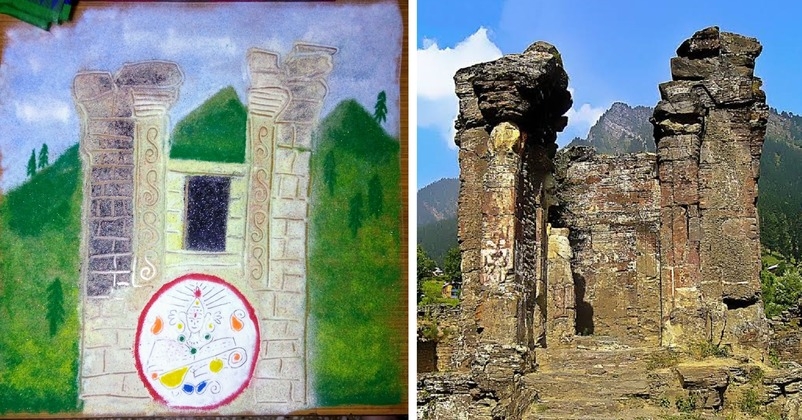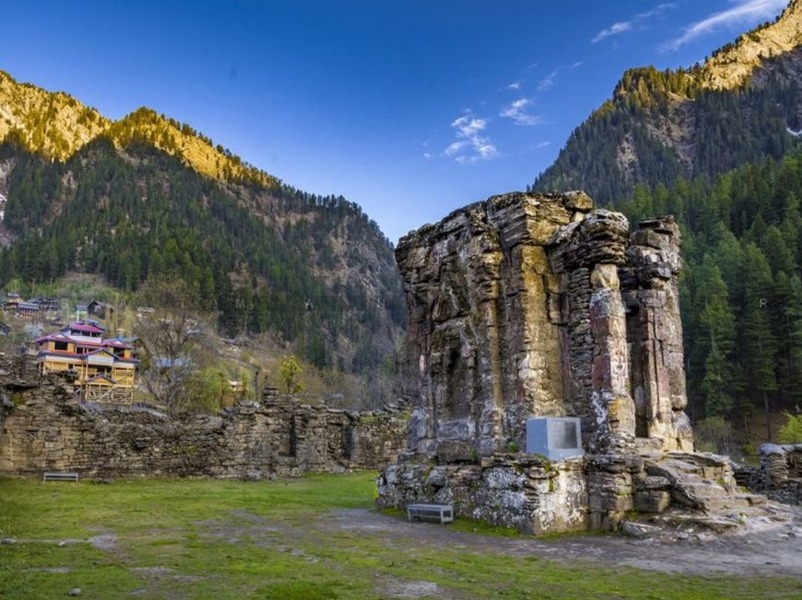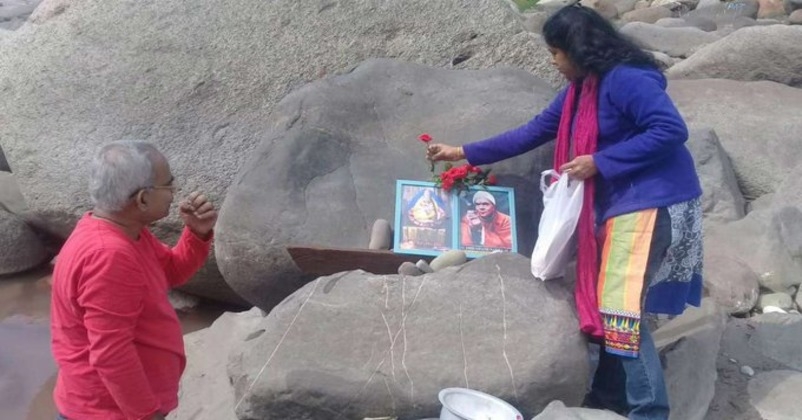Significance of Sharda Ashtami, “Sharda Peeth” and why Kashmiri Hindus are so attached to it?
| 27-Aug-2020 |

On the occasion of ‘Sharda Ashtami’ thursday, a “rangoli” went viral on Twitter after which many Kashmiri Hindus reacting emotionally to the post shared their individual emotions attached with the historical place of ancient India which unfortunately is in Pakistan Occupied Jammu Kashmir (POJK) today. Although in ruins, Sharda Peeth, one of the Maha Shakti Peeths is the rich cultural heritage of Kashmiri Hindus, who are extremely proud of it and thus have unitedly pledged over again to restore the ancient centre of learning.
‘Sharda Ashtami’, a unique ritual dedicated to the dead ancestors and relatives is observed every year with religious fervor and is also known as ‘Ganga Ashtami’. On this day, the ashes of those who died during the past year are immersed in the Gangabal lake, also known as Harmukh/Harmukata Lake. Sharda is a Sanskrit and Kashmiri name of goddess Sarawati, the goddess of knowledge. The temple known as Sharda Peeth, an iconic shrine also translates to the seat of goddess Sharda.
Only recently, on the occasion of stone laying foundation ceremony for the construction of Shri Ram Mandir in Ayodhya, the pious soil of Sharda Peeth, along with the soil collected from various parts of the country was sent to Ayodhya by the Save Sharda Committee, Kashmir. SSCK has been struggling for more than two decades for the exploration of Sharda Peeth and reopening it for pilgrimage. The soil was brought from Sharda Peeth in POJK and was handed over by Ravinder Pandita, founder of SSCK to the working president of VHP.
An iconic shrine, Sharda Peeth and the significance of ‘Sharda Ashtami’ for the Kashmiri Hindus

The Kashmiri Pandits consider the learning centre/temple, Sharda Peeth as important because of their cultural heritage and glory of their land from ancient times. As part of their daily worship, Kashmiri Hindus utter the phrase" "Namastey Sharada Devi Kashmir Pur Vasini Tvam Ham Prartheye Nityam Vidya Danam Che De hi mey" (Salutations to you, O Sharada, O Goddess, O one who resides in Kashmir. I pray to you daily, please give me the charity of knowledge).
Sharda Peeth is one of the holiest sites of pilgrimage for Kashmiri Pandits. Although completely deserted today, It was once regarded as a major centre of higher learning of Vedic works, scriptures, and commentaries. Before partition, on the day of ‘Sharda Ashtami’, Kashmiri Hindus would take part in the annual yatra to Sharda Peeth, one of the 18 ‘Shakti Peeths’ across South Asia which was famous during Adi Shankracharya era and late Swami Nand Lal ji, a Kashmiri saint who was the last to sit on Sharda Peeth up to 1948, much after tribal intrusion in India. The annual yatra to the Peeth would take place along three to four designated routes in the Kupwara sector of J&K.
Every year on this day, Save Sharda Committee Kashmir, instrumental in getting flowers laid, photos installed and securing SC of POJK Order on preservation of the Peeth that lies in ruins in Sharda village of District Neelum in POJK now hails the cultural richness of the displaced community and organises a ‘Bhandara’ for the devotees post ‘Hawan’ performance along with a large section of Sharda followers. It was due to their efforts that an order for restoration had also been issued by DG Archaeology & Tourism POJK in December 2018 which was followed by a 5 member Hindu delegation who visited to Sharda Peeth in June 2019. SSCK has come into prominence after getting flowers laid at Sharda Peeth in POJK, the highest Peeth of Shankaracharya followers in 2006. Later in March 2007 through the civil society of POJK, a photo of Sharda Mai was installed there in the temple and in January 2019, the committee secured a landmark judgement on the preservation of Sharda Peeth by the Supreme Court of POJK.
The story behind the foundation of Sharda Peeth and why Kashmiri Hindus are denied access to it today
The story behind the foundation of the Sharada Peeth goes back to the time when the Kashmiri Pandits transformed their land of scenic beauty into an intellectual centre, known as Sharada Peeth or Sarvajnanpeetha. Goddess Sharada was also referred to as Kashmira-Puravasani. The temple has been completely deserted since Partition in 1947. Travel restrictions on Indians also discouraged the devotees from visiting the shrine. However, devoid of devotees the shrine still stands tall in POJK.

First time in 72 years, Indian Hindu couple performed puja at Sharada Peeth in 2019
Sharda Peeth lies in ruins in Sharda village of District Neelum in POJK now and Kashmiri Hindus do not have access to Sharda Peeth, ever since Pakistani tribals intruded in India during 1947-48 and occupied the area. The Neelum Valley is one of the most sensitive sub-sectors in the vicinity of the Line of Control (LoC). From Kel in the North via Athmuqam and Dudniyal to Tithwal (our side) the valley is under the complete domination of the Indian fortified positions along the LoC. There is a cartographic bulge on the eastern side called the Bugina Bulge which is a swathe of territory hugging the slopes of the Shamashabari. This is the sub-sector of the Pakistan side which is used for launch pads to infiltrate terrorists into the Kupwara sector of Kashmir.
Meanwhile, restoring Sharda Peeth to begin the Sharda pilgrimage has been the life mission of many Kashmiri Pandits who on the occasion of 'Sharda Ashtami' have once again expressed their strong emotions attached to the holy shrine and learning centre of ancient India. With new hopes, they have pledged to reclaim their iconic Maha Shakti Peeth, Sharda Peeth, and will continue to do so until its regained.